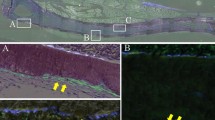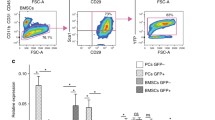Abstract
During the healing process after bone fracture, soft callus forms adjacent to the fracture site, is replaced by hard callus, and is finally remodeled to the original bone configuration. Although the cambium layer of the periosteum is reported to play an essential role in callus formation, we still lack direct in vivo evidence of this. To investigate the cell lineage of the soft callus, we analyzed the process of fracture healing in Prx1-Cre;ROSA26 reporter (R26R), Col1a1(3.6 kb)-Cre;R26R, Col1a1(2.3 kb)-Cre;R26R, Sox9-CreERT2;R26R, and Sox9-LacZ mice with X-gal staining. In the Prx1-Cre;R26R, in which the cells of the periosteum stained for X-gal before fracture, all cells in the soft callus were X-gal positive, whereas in the Col1a1(3.6 kb)-Cre;R26R mice, the cells in the periosteum before fracture stained for X-gal and the soft callus was partly composed of X-gal-positive cells. In contrast, in the Col1a1(2.3 kb)-Cre;R26R mice, in which the mature osteoblasts in the cambium layer of the periosteum were marked before fracture, no cells in the soft callus at the fracture site were X-gal positive. These results suggest that most of the cells in the soft callus are derived from the mesenchymal progenitors in the periosteum, and not from mature osteoblastic cells. Interestingly, in the Sox9-LacZ mice, Sox9-expressing X-gal-positive cells emerged in the periosteum adjacent to the fracture site 3 days after fracture. We demonstrated this by injecting tamoxifen into the Sox9-CreERT2;R26R mice for 3 days after fracture, so that these Sox9-expressing periosteal cells gave rise to cells in the soft and hard calli. Our findings show that the periosteal cells in which Sox9 expression is induced just after fracture are the major source of the chondrocytes and osteoblasts in the fracture callus.






Similar content being viewed by others
References
Squier CA, Ghoneim S, Kremenak CR (1990) Ultrastructure of the periosteum from membrane bone. J Anat 171:233–239
Schindeler A, McDonald MM, Bokko P, Little DG (2008) Bone remodeling during fracture repair: the cellular picture. Semin Cell Dev Biol 19:459–466
Farrington-Rock C, Crofts NJ, Doherty MJ, Ashton BA, Griffin-Jones C, Canfield AE (2004) Chondrogenic and adipogenic potential of microvascular pericytes. Circulation 110:2226–2232
Zuk PA, Zhu M, Mizuno H, Huang J, Futrell JW, Katz AJ, Benhaim P, Lorenz HP, Hedrick MH (2001) Multilineage cells from human adipose tissue: implications for cell-based therapies. Tissue Eng 7:211–228
Lee JY, Qu-Petersen Z, Cao B, Kimura S, Jankowski R, Cummins J, Usas A, Gates C, Robbins P, Wernig A, Huard J (2000) Clonal isolation of muscle-derived cells capable of enhancing muscle regeneration and bone healing. J Cell Biol 150:1085–1100
Kojimoto H, Yasui N, Goto T, Matsuda S, Shimomura Y (1988) Bone lengthening in rabbits by callus distraction. The role of periosteum and endosteum. J Bone Joint Surg Br 70:543–549
Colnot C (2009) Skeletal cell fate decisions within periosteum and bone marrow during bone regeneration. J Bone Miner Res 24:274–282
Ito Y, Fitzsimmons JS, Sanyal A, Mello MA, Mukherjee N, O’Driscoll SW (2001) Localization of chondrocyte precursors in periosteum. Osteoarthritis Cartilage 9:215–223
Akiyama H, Chaboissier MC, Martin JF, Schedl A, de Crombrugghe B (2002) The transcription factor Sox9 has essential roles in successive steps of the chondrocyte differentiation pathway and is required for expression of Sox5 and Sox6. Genes Dev 16:2813–2828
Akiyama H, Kim JE, Nakashima K, Balmes G, Iwai N, Deng JM, Zhang Z, Martin JF, Behringer RR, Nakamura T, de Crombrugghe B (2005) Osteo-chondroprogenitor cells are derived from Sox9 expressing precursors. Proc Natl Acad Sci USA 102:14665–14670
Soeda T, Deng JM, de Crombrugghe B, Behringer RR, Nakamura T, Akiyama H (2010) Sox9-expressing precursors are the cellular origin of the cruciate ligament of the knee joint and the limb tendons. Genesis 48:635–644
Martin JF, Olson EN (2000) Identification of a prx1 limb enhancer. Genesis 26:225–229
Nakanishi R, Akiyama H, Kimura H, Otsuki B, Shimizu M, Tsuboyama T, Nakamura T (2008) Osteoblast-targeted expression of Sfrp4 in mice results in low bone mass. J Bone Miner Res 23:271–277
Zhu J, Nakamura E, Nguyen MT, Bao X, Akiyama H, Mackem S (2008) Uncoupling Sonic hedgehog control of pattern and expansion of the developing limb bud. Dev Cell 14:624–632
Soriano P (1999) Generalized lacZ expression with the ROSA26 Cre reporter strain. Nat Genet 21:70–71
Hogan B, Costantini F, Beddington R (1994) Manipulating the mouse embryo: a laboratory manual. Cold Spring Harbor Laboratory Press, New York
Tavassoli M, Crosby WH (1968) Transplantation of marrow to extramedullary sites. Science 161:54–56
Friedenstein AJ, Petrakova KV, Kurolesova AI, Frolova GP (1968) Heterotopic of bone marrow: analysis of precursor cells for osteogenic and hematopoietic tissues. Transplantation 6:230–247
Brighton CT, Hunt RM (1997) Early histologic and ultrastructural changes in microvessels of periosteal callus. J Orthop Trauma 11:244–253
Usas A, Ho AM, Cooper GM, Olshanski A, Peng H, Huard J (2009) Bone regeneration mediated by BMP4-expressing muscle-derived stem cells is affected by delivery system. Tissue Eng Part A 15:285–293
Matsumoto T, Kawamoto A, Kuroda R, Ishikawa M, Mifune Y, Iwasaki H, Miwa M, Horii M, Hayashi S, Oyamada A, Nishimura H, Murasawa S, Doita M, Kurosaka M, Asahara T (2006) Therapeutic potential of vasculogenesis and osteogenesis promoted by peripheral blood CD34-positive cells for functional bone healing. Am J Pathol 169:1440–1457
Ozaki A, Tsunoda M, Kinoshita S, Saura R (2000) Role of fracture hematoma and periosteum during fracture healing in rats: interaction of fracture hematoma and the periosteum in the initial step of the healing process. J Orthop Sci 5:64–70
Kawanami A, Matsushita T, Chan YY, Murakami S (2009) Mice expressing GFP and CreER in osteochondroprogenitor cells in the periosteum. Biochem Biophys Res Commun 386:477–482
Boban I, Jacquin C, Prior K, Barisic-Dujmovic T, Maye P, Clark SH, Aguila HL (2006) The 3.6 kb DNA fragment from the rat Col1a1 gene promoter drives the expression of genes in both osteoblast and osteoclast lineage cells. Bone 39:1302–1312
Dacic S, Kalajzic I, Visnjic D, Lichtler AC, Rowe DW (2001) Col1a1-driven transgenic markers of osteoblast lineage progression. J Bone Miner Res 16:1228–1236
Kalajzic I, Kalajzic Z, Kaliterna M, Gronowicz G, Clark SH, Lichtler AC, Rowe D (2002) Use of type I collagen green fluorescent protein transgenes to identify subpopulations of cells at different stages of the osteoblast lineage. J Bone Miner Res 17:15–25
Acknowledgments
We thank James F. Martin, Philippe Soriano, Chisa Shukunami, and Richard R. Behringer for their valuable help. This work was supported by Grants-in-Aid for Scientific Research from the Japanese Ministry of Education, Culture, Sports, Science, and Technology (#21249078 and #23659717 to HA and #22791376 to KY).
Conflict of interest
All authors have no conflicts of interest.
Author information
Authors and Affiliations
Corresponding author
Additional information
H. Murao and K. Yamamoto contributed equally to this work.
About this article
Cite this article
Murao, H., Yamamoto, K., Matsuda, S. et al. Periosteal cells are a major source of soft callus in bone fracture. J Bone Miner Metab 31, 390–398 (2013). https://doi.org/10.1007/s00774-013-0429-x
Received:
Accepted:
Published:
Issue Date:
DOI: https://doi.org/10.1007/s00774-013-0429-x




